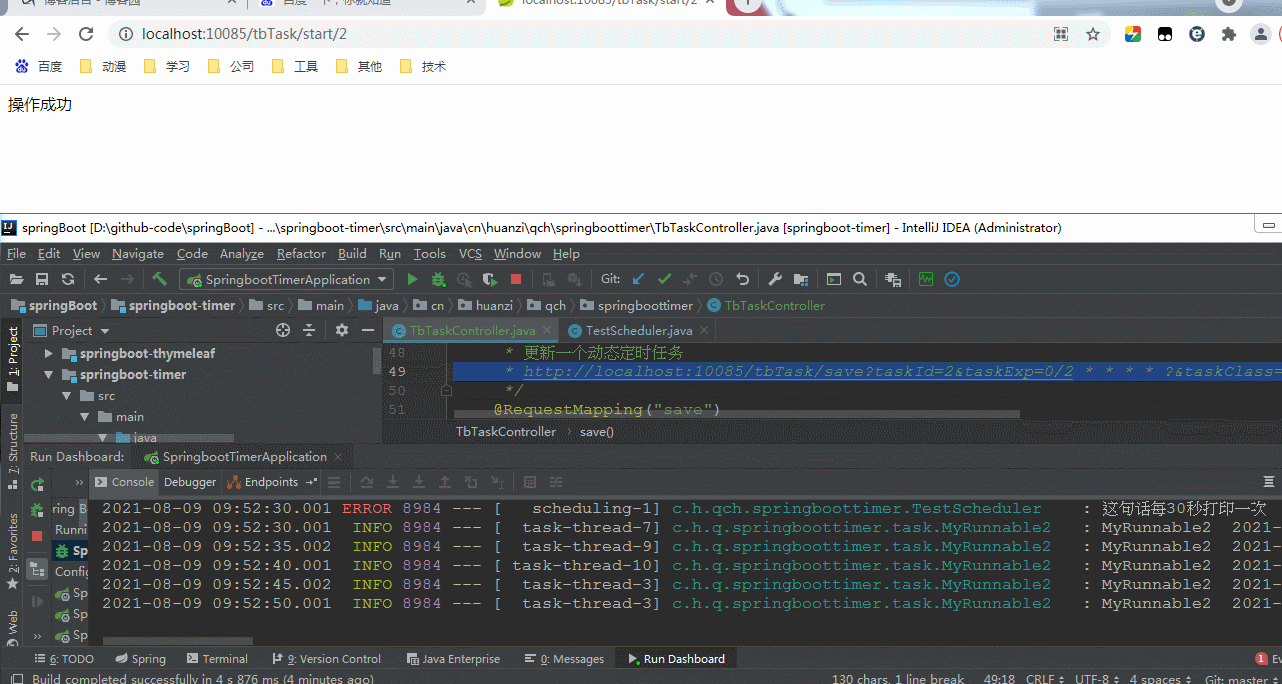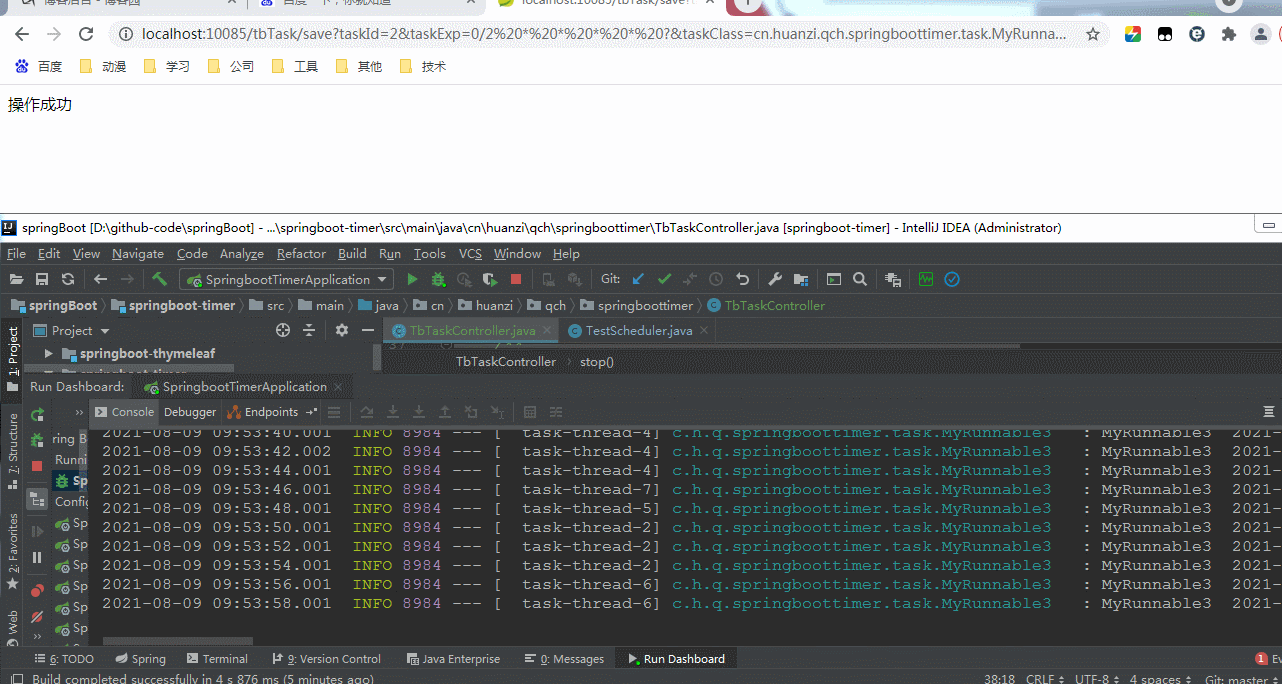SpringBoot动态定时任务 SpringBoot开发实战系列之动态定时任务
huanzi-qch 人气:0前言
定时器是我们项目中经常会用到的,SpringBoot使用@Scheduled注解可以快速启用一个简单的定时器(详情请看我们之前的博客《SpringBoot系列——定时器》),然而这种方式的定时器缺乏灵活性,如果需要对定时器进行调整,需要重启项目才生效,本文记录SpringBoot如何灵活配置动态定时任务
代码编写
首先先建表,重要字段:唯一表id、Runnable任务类、Cron表达式,其他的都是一些额外补充字段
DROP TABLE IF EXISTS `tb_task`;
CREATE TABLE `tb_task` (
`task_id` varchar(255) CHARACTER SET utf8 COLLATE utf8_general_ci NOT NULL COMMENT '定时任务id',
`task_name` varchar(255) CHARACTER SET utf8 COLLATE utf8_general_ci NULL DEFAULT NULL COMMENT '定时任务名称',
`task_desc` varchar(255) CHARACTER SET utf8 COLLATE utf8_general_ci NULL DEFAULT NULL COMMENT '定时任务描述',
`task_exp` varchar(255) CHARACTER SET utf8 COLLATE utf8_general_ci NULL DEFAULT NULL COMMENT '定时任务Cron表达式',
`task_status` int(1) NULL DEFAULT NULL COMMENT '定时任务状态,0停用 1启用',
`task_class` varchar(255) CHARACTER SET utf8 COLLATE utf8_general_ci NULL DEFAULT NULL COMMENT '定时任务的Runnable任务类完整路径',
`update_time` datetime NULL DEFAULT NULL COMMENT '更新时间',
`create_time` datetime NULL DEFAULT NULL COMMENT '创建时间',
PRIMARY KEY (`task_id`) USING BTREE
) ENGINE = InnoDB CHARACTER SET = utf8 COLLATE = utf8_general_ci COMMENT = '动态定时任务表' ROW_FORMAT = Compact;
INSERT INTO `tb_task` VALUES ('1', 'task1', '测试动态定时任务1', '0/5 * * * * ?', 0, 'cn.huanzi.qch.springboottimer.task.MyRunnable1', '2021-08-06 17:39:23', '2021-08-06 17:39:25');
INSERT INTO `tb_task` VALUES ('2', 'task2', '测试动态定时任务2', '0/5 * * * * ?', 0, 'cn.huanzi.qch.springboottimer.task.MyRunnable2', '2021-08-06 17:39:23', '2021-08-06 17:39:25');
项目引入jpa、数据库驱动,用于数据库操作
<!--添加springdata-jpa依赖 -->
<dependency>
<groupId>org.springframework.boot</groupId>
<artifactId>spring-boot-starter-data-jpa</artifactId>
</dependency>
<!--添加MySQL驱动依赖 -->
<dependency>
<groupId>mysql</groupId>
<artifactId>mysql-connector-java</artifactId>
</dependency>
数据库相关配置文件
spring:
datasource: #数据库相关
url: jdbc:mysql://localhost:3306/test?serverTimezone=GMT%2B8&characterEncoding=utf-8
username: root
password: 123456
driver-class-name: com.mysql.jdbc.Driver
mvc:
date-format: yyyy-MM-dd HH:mm:ss #mvc接收参数时对日期进行格式化
jackson:
date-format: yyyy-MM-dd HH:mm:ss #jackson对响应回去的日期参数进行格式化
time-zone: GMT+8
jpa:
show-sql: true
entity实体与数据表映射,以及与之对应的repository
/**
* 动态定时任务表
* 重要属性:唯一表id、Runnable任务类、Cron表达式,
* 其他的都是一些额外补充说明属性
*/
@Entity
@Table(name = "tb_task")
@Data
public class TbTask {
@Id
private String taskId;//定时任务id
private String taskName;//定时任务名称
private String taskDesc;//定时任务描述
private String taskExp;//定时任务Cron表达式
private Integer taskStatus;//定时任务状态,0停用 1启用
private String taskClass;//定时任务的Runnable任务类完整路径
private Date updateTime;//更新时间
private Date createTime;//创建时间
}
/**
* TbTask动态定时任务Repository
*/
@Repository
public interface TbTaskRepository extends JpaRepository<TbTask,String>, JpaSpecificationExecutor<TbTask> {
}
测试动态定时器的配置类,主要作用:初始化线程池任务调度、读取/更新数据库任务、启动/停止定时器等
/**
* 测试定时器2-动态定时器
*/
@Slf4j
@Component
public class TestScheduler2 {
//数据库的任务
public static ConcurrentHashMap<String, TbTask> tasks = new ConcurrentHashMap<>(10);
//正在运行的任务
public static ConcurrentHashMap<String,ScheduledFuture> runTasks = new ConcurrentHashMap<>(10);
//线程池任务调度
private ThreadPoolTaskScheduler threadPoolTaskScheduler = new ThreadPoolTaskScheduler();
@Autowired
private TbTaskRepository tbTaskRepository;
/**
* 初始化线程池任务调度
*/
@Autowired
public TestScheduler2(){
this.threadPoolTaskScheduler.setPoolSize(10);
this.threadPoolTaskScheduler.setThreadNamePrefix("task-thread-");
this.threadPoolTaskScheduler.setWaitForTasksToCompleteOnShutdown(true);
this.threadPoolTaskScheduler.initialize();
}
/**
* 获取所有数据库里的定时任务
*/
private void getAllTbTask(){
//查询所有,并put到tasks
TestScheduler2.tasks.clear();
List<TbTask> list = tbTaskRepository.findAll();
list.forEach((task)-> TestScheduler2.tasks.put(task.getTaskId(),task));
}
/**
* 根据定时任务id,启动定时任务
*/
void start(String taskId){
try {
//如果为空,重新获取
if(TestScheduler2.tasks.size() <= 0){
this.getAllTbTask();
}
TbTask tbTask = TestScheduler2.tasks.get(taskId);
//获取并实例化Runnable任务类
Class<?> clazz = Class.forName(tbTask.getTaskClass());
Runnable runnable = (Runnable)clazz.newInstance();
//Cron表达式
CronTrigger cron = new CronTrigger(tbTask.getTaskExp());
//执行,并put到runTasks
TestScheduler2.runTasks.put(taskId, Objects.requireNonNull(this.threadPoolTaskScheduler.schedule(runnable, cron)));
this.updateTaskStatus(taskId,1);
log.info("{},任务启动!",taskId);
} catch (ClassNotFoundException | InstantiationException | IllegalAccessException e) {
log.error("{},任务启动失败...",taskId);
e.printStackTrace();
}
}
/**
* 根据定时任务id,停止定时任务
*/
void stop(String taskId){
TestScheduler2.runTasks.get(taskId).cancel(true);
TestScheduler2.runTasks.remove(taskId);
this.updateTaskStatus(taskId,0);
log.info("{},任务停止...",taskId);
}
/**
* 更新数据库动态定时任务状态
*/
private void updateTaskStatus(String taskId,int status){
TbTask task = tbTaskRepository.getOne(taskId);
task.setTaskStatus(status);
task.setUpdateTime(new Date());
tbTaskRepository.save(task);
}
}
接下来就是编写测试接口、测试Runnable类(3个Runnable类,这里就不贴那么多了,就贴个MyRunnable1)
/**
* Runnable任务类1
*/
@Slf4j
public class MyRunnable1 implements Runnable {
@Override
public void run() {
log.info("MyRunnable1 {}",new SimpleDateFormat("yyyy-MM-dd HH:mm:ss").format(new Date()));
}
}
Controller接口
/**
* 动态定时任务Controller测试
*/
@RestController
@RequestMapping("/tbTask/")
public class TbTaskController {
@Autowired
private TestScheduler2 testScheduler2;
@Autowired
private TbTaskRepository tbTaskRepository;
/**
* 启动一个动态定时任务
* http://localhost:10085/tbTask/start/2
*/
@RequestMapping("start/{taskId}")
public String start(@PathVariable("taskId") String taskId){
testScheduler2.start(taskId);
return "操作成功";
}
/**
* 停止一个动态定时任务
* http://localhost:10085/tbTask/stop/2
*/
@RequestMapping("stop/{taskId}")
public String stop(@PathVariable("taskId") String taskId){
testScheduler2.stop(taskId);
return "操作成功";
}
/**
* 更新一个动态定时任务
* http://localhost:10085/tbTask/save?taskId=2&taskExp=0/2 * * * * ?&taskClass=cn.huanzi.qch.springboottimer.task.MyRunnable3
*/
@RequestMapping("save")
public String save(TbTask task) throws IllegalAccessException {
//先更新表数据
TbTask tbTask = tbTaskRepository.getOne(task.getTaskId());
//null值忽略
List<String> ignoreProperties = new ArrayList<>(7);
//反射获取Class的属性(Field表示类中的成员变量)
for (Field field : task.getClass().getDeclaredFields()) {
//获取授权
field.setAccessible(true);
//属性名称
String fieldName = field.getName();
//属性的值
Object fieldValue = field.get(task);
//找出值为空的属性,我们复制的时候不进行赋值
if(null == fieldValue){
ignoreProperties.add(fieldName);
}
}
//org.springframework.beans BeanUtils.copyProperties(A,B):A中的值付给B
BeanUtils.copyProperties(task, tbTask,ignoreProperties.toArray(new String[0]));
tbTaskRepository.save(tbTask);
TestScheduler2.tasks.clear();
//停止旧任务
testScheduler2.stop(tbTask.getTaskId());
//重新启动
testScheduler2.start(tbTask.getTaskId());
return "操作成功";
}
}
效果演示
启动
启动一个定时任务,http://localhost:10085/tbTask/start/2

可以看到,id为2的定时任务已经被启动,corn表达式为5秒执行一次,runnable任务为MyRunnable2
修改
修改一个定时任务,http://localhost:10085/tbTask/save?taskId=2&taskExp=0/2 * * * * ?&taskClass=cn.huanzi.qch.springboottimer.task.MyRunnable3

调用修改后,数据库信息被修改,id为2的旧任务被停止重新启用新任务,corn表达式为2秒执行一次,runnable任务类为MyRunnable3
停止
停止一个定时任务,http://localhost:10085/tbTask/stop/2

id为2的定时任务被停止
后记
可以看到,配置动态定时任务后,可以方便、实时的对定时任务进行修改、调整,再也不用重启项目啦
SpringBoot配置动态定时任务暂时先记录到这,后续再进行补充
代码开源
代码已经开源、托管到我的GitHub、码云:
GitHub:https://github.com/huanzi-qch/springBoot
码云:https://gitee.com/huanzi-qch/springBoot
加载全部内容